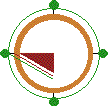Megalithic Yard Unearthed | home
Megalithic Yard Surprises | Was Thom misled? | Woodhenge | Stonehenge and Sarsen circle | The Lintel Circle | Hawkins' Photogrammetry | Trilithon ellipse | Megalithic Foot and Megalithic Inch | Arcs, chords & sagitta | Pi-Pyramid and the Megalithic Yard | Map Scales | Miles and the Equator | Additions, Vara etc. | Contact Me | CALCULATOR
Additions, Vara etc.
 (NEW ! The VARA, and a CARNAC note at bottom of page.)
(NEW ! The VARA, and a CARNAC note at bottom of page.)Here are some Arabian measures that I have taken down from a conversion programme I found on the net.
It is called ProKon, from
Harold Schwartz, ShowMe Software, PO Box 104482,Jefferson City. Mo.65110
( N.B. These units do not appear in Dents Dictionary of Measurement 1994, and may vary slightly with other sources.)
Arabian
Feet
|
English
Feet
|
Equivalent to
|
|
Barid
|
7200
|
75398.548556
|
24000p ft
|
Mille
|
6000
|
6283.2122703
|
2000p ft.
|
Qasab
|
12
|
12.5664247
|
4p ft.
|
Foot
|
1
|
1.04720206
|
p/3 ft.
|
Cabda
|
1/4
|
.26246719
|
p/12 ft.
|
One Cubit
|
-
|
1.7734269
|
Öp ft.
|
One Assba
|
-
|
.06561679
|
Öp*Ö2*p/120 ft.
|
There is another Arabian unit called the Galva. Equivalent to 756 English ft., which is a pretty good rounding off of the Gt. Pyramid base.
We have become used to saying that a circumference is "diameter x Pi", but taking an example from the above table, it can be said that the circumference is 2000 lengths of a unit called Pi.
And so with the Meg Yard. If the Short Side of the triangle has 4 units, then the circumference can be said to be 16 lengths of a unit called M.
The Foot
Aubrey Burl, in his book 'Stone Circles of the British Isles' 1976 ,pp.40-41, has impressive tables and graphs showing Stone circles which have their diameters measured in Imperial Feet. Peaks fall regularly at 10 ft. intervals.
He remarks ".... as it cannot be believed that Prehistoric man measured in units of ten Imperial feet with occasional 5 ft. divisions, it is evident that many modern surveyors have been content to approximate diameters to the nearest 10 feet."
(I cannot believe that modern surveyors would stop 10 ft., let alone 5 ft. short, on the diameter of a circle and say "That'll do!").
Elsewhere, pg. 72, whilst discussing the 6" markings on the measuring rod from a Danish tumulus, and various ancient 'feet', he remarks that "...... It would be ironical if, after all, the linear measure used in stone circles was akin to the Imperial Foot."
(An SS of 6" , would produce a circumference of 2 MY).
Having found that measuring integer circumferences in "quadrants" by using a smaller measure in the SS of the triangle, the next step by prehistoric man would be to experiment with the small measure (the Foot) in other ways, e.g. diameters.
Any Diameter measured in Feet, multiplied by 2 and divided by Ö3, gives the circumference in Meg Yards.
Either the MY came first by some independent method and gave rise to the Foot, or it was the other way round.
CARNAC
In 'Sun Moon and Standing Stones', J.E Wood on page151, whilst discussing the constant in the formula used to determine the convergence of the stone rows, asks if there is any significance in the value of the constant .00102
For what it is worth, the reciprocal of 360M is .001020979...
VARA
Thom thought that the Spanish Vara, ranging from 2.72 to 2.78 ft., (with the standard Vara of Burgos of the XVI th century, at 2.7424ft.), might be a hangover or successor to the Megalithic Yard, consequently spread to the provinces of the New World.
Well within this range lies 2.75 ft, or 33 inches, which we can see if used as a Short Side to the 30/60 degree triangle, would give a circumference of 11 MY.
In Texas in 1900, the VARA was standardisd at 33 and 1/3rd inches, or 2.777.. ft., this means that 360 Varas equalled 1000 English feet.
Now, if 33.333 inches were to be used as a Short Side, the circumference would be 11.1111 MY or 30.22999 ft. One hundred circumferences would be equal to the perimeter of the Gt. Pyramid with sides of 755.749+ ft., or as noted previously, 100,000MY / 360.
For an enlightening account of the Vara, and how land was measured by horsemen stretching a "cordel" of 10 or 50 Varas between them, the paper by Pauley (parts 1 and 2) must be read. Find it here at :-